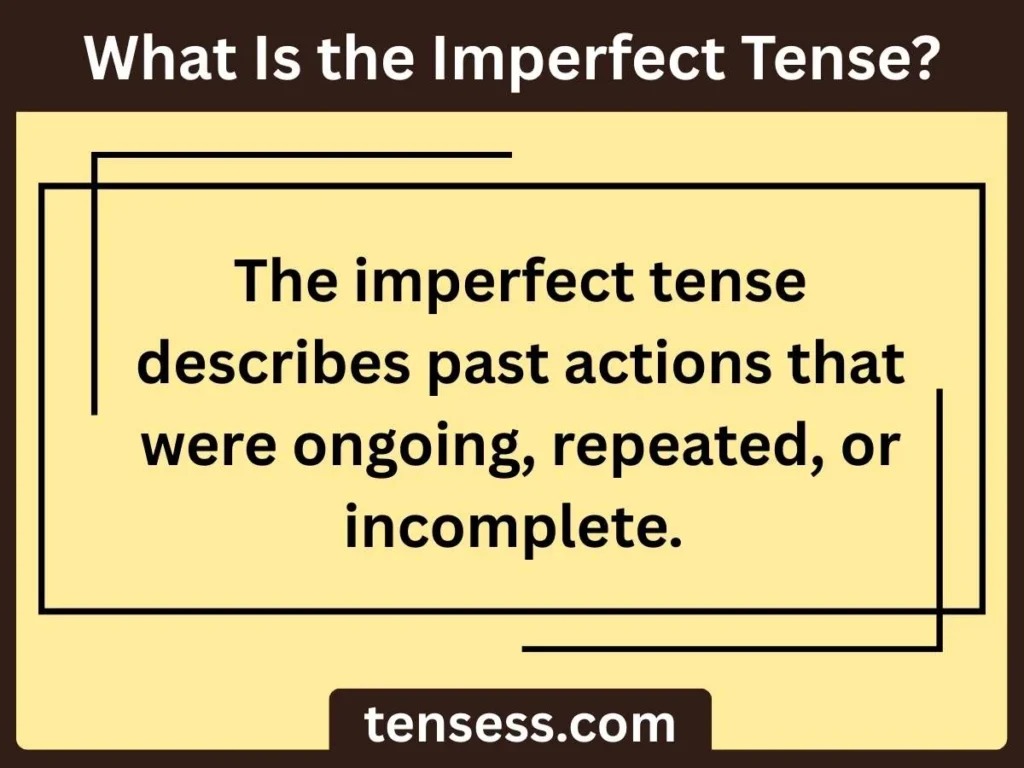The imperfect tense is a vital tool for anyone learning a language, especially students, writers, and grammar enthusiasts.
This tense allows you to describe ongoing, habitual, or incomplete actions in the past, painting vivid pictures of what was happening at a specific moment.
If you’re a language learner crafting sentences or a writer aiming for precision, understanding the imperfect tense is key to clear communication.
In this article, we’ll break down its definition, structure, and usage with verb tense examples to make it approachable.
We’ll cover how to recognize, form, and conjugate verbs in the imperfect tense, provide real-life examples, and share tips to avoid common mistakes.
By the end, you’ll feel confident using this tense in your writing or conversations.
Let’s dive into the world of the imperfect tense and explore how it brings the past to life with clarity and nuance!
What Is the Imperfect Tense?

Unlike the preterite tense, which focuses on completed actions, the imperfect tense sets the scene or describes habits. For example, it’s used for actions like “I was reading” or “She used to sing.” It’s common in storytelling, background descriptions, or when discussing past routines. In languages like Spanish, French, or Italian, the imperfect tense is a cornerstone of past-tense narration, offering a way to express what was happening over time.
Recognition

For instance, “They were playing soccer every weekend” uses the imperfect tense to show a repeated past action. In contrast, “They played soccer yesterday” (preterite) indicates a one-time event. Pay attention to verb endings, which differ by language but often follow consistent patterns (e.g., -aba in Spanish for -ar verbs).
Structure of Sentence

A sentence in the imperfect tense typically follows this structure:
For example:
- I was studying in the library. (English)
- Yo estudiaba en la biblioteca. (Spanish)
The verb is conjugated to match the subject and tense, with adverbs or phrases like “every day” or “at that moment” providing context. The imperfect tense often pairs with time expressions to clarify the ongoing or habitual nature of the action.
Formation

In Spanish, you take the verb’s infinitive, remove the ending (-ar, -er, -ir), and add specific endings (e.g., -aba, -ía). French uses endings like -ais or -ait. The process involves:
- Identify the verb’s infinitive.
- Drop the infinitive ending.
- Add the imperfect tense endings for the subject.
Regular verbs follow predictable patterns, while irregular verbs may have unique stems or endings.
Verbs
The imperfect tense works with most verbs, including action verbs (e.g., “run,” “write”) and stative verbs (e.g., “know,” “feel”). In English, it’s commonly formed with “to be” (was/were) plus a present participle. In Romance languages, both regular and irregular verbs can take imperfect tense forms, though irregular verbs like “to be” or “to go” may have special conjugations.
Helping Verbs
In English, helping verbs like “was” or “were” are essential for the imperfect tense (e.g., “She was singing”). In other languages, the imperfect tense is often formed without auxiliary verbs, relying on specific endings. For example, in Spanish, “cantaba” (I was singing) doesn’t need a separate helping verb. Understanding the role of helping verbs is crucial for correct tense formation.
Define the Verb in the Imperfect Tense
In the imperfect tense, a verb describes an action that was ongoing, habitual, or incomplete in the past. For example, “to study” becomes “was studying” (English) or “estudiaba” (Spanish), indicating the action was in progress or repeated. The verb’s form changes based on the subject and language-specific rules.
Regular or Irregular Verbs
Most verbs in the imperfect tense are regular, following standard conjugation patterns. For example, in Spanish, -ar verbs add -aba (e.g., hablar → hablaba). However, some verbs are irregular, like “ser” (to be) in Spanish, which becomes “era.” Irregular verbs require memorizing unique stems or forms, but they’re limited in number.
10 Simple Sentence Examples
Here are 10 simple imperfect tense examples in English and Spanish with varied subjects:
- I was reading a book. (Yo leía un libro.)
- We were playing soccer. (Nosotros jugábamos al fútbol.)
- They were talking loudly. (Ellos hablaban fuerte.)
- She was writing a letter. (Ella escribía una carta.)
- He was running every morning. (Él corría cada mañana.)
- You were studying all night. (Tú estudiabas toda la noche.)
- It was raining heavily. (Llovía mucho.)
- The dog was barking constantly. (El perro ladraba constantemente.)
- The children were laughing happily. (Los niños reían felices.)
- My parents were cooking dinner. (Mis padres cocinaban la cena.)
How to Conjugate the Imperfect Tense (10 Points)
To conjugate verbs in the imperfect tense, follow these steps (using Spanish as an example):
- Identify the verb’s infinitive (e.g., hablar, comer, vivir).
- Remove the infinitive ending (-ar, -er, -ir).
- Add the appropriate imperfect tense endings based on the subject.
- For -ar verbs, use endings: -aba, -abas, -aba, -ábamos, -abais, -aban.
- For -er/-ir verbs, use endings: -ía, -ías, -ía, -íamos, -íais, -ían.
- Check for irregular verbs (e.g., ser → era, ir → iba).
- Ensure the stem remains consistent for regular verbs.
- Practice with different subjects.
- Use context clues to confirm the tense fits the sentence.
- Review conjugations regularly to build fluency.
Conjugation Table
Here’s a conjugation table for the Spanish verb “hablar” (to speak) in the imperfect tense:
| Subject | Conjugation |
| Yo | hablaba |
| Tú | hablabas |
| Él/Ella | hablaba |
| Nosotros | hablábamos |
| Vosotros | hablabais |
| Ellos | hablaban |
For irregular verbs like “ser”:
| Subject | Conjugation |
| Yo | era |
| Tú | eras |
| Él/Ella | era |
| Nosotros | éramos |
| Vosotros | erais |
| Ellos | eran |
Spelling Changes or Irregularities
Most imperfect tense verbs are regular, but some have irregularities:
- In Spanish, “ser” (to be) uses the stem “er-” (era, eras, etc.).
- “Ir” (to go) uses “ib-” (iba, ibas, etc.).
- “Ver” (to see) uses “ve-” (veía, veías, etc.).
- No spelling changes occur in regular verbs.
- English imperfect tense has no spelling changes, relying on “was/were.”
- French irregular verbs like “être” (to be) use unique stems (étais, était).
- Check language-specific rules for exceptions.
- Memorize irregular forms early.
- Practice with common irregular verbs.
- Use conjugation charts for reference.
Examples of Imperfect Tense Sentences
Here are 10 more imperfect tense examples with varied subjects:
- I was walking to school. (Yo caminaba a la escuela.)
- We were watching TV. (Nosotros veíamos televisión.)
- They were dancing at the party. (Ellos bailaban en la fiesta.)
- She was singing beautifully. (Ella cantaba hermosamente.)
- He was reading a novel. (Él leía una novela.)
- You were working hard. (Tú trabajabas mucho.)
- It was snowing all day. (Nevaba todo el día.)
- The kids were playing outside. (Los niños jugaban afuera.)
- My friend was talking on the phone. (Mi amigo hablaba por teléfono.)
- The teacher was explaining the lesson. (La profesora explicaba la lección.)
Common Mistakes with Imperfect Tense
Avoid these frequent errors when using the imperfect tense:
- Confusing it with the preterite tense (completed actions).
- Using incorrect verb endings (e.g., -aba instead of -ía).
- Forgetting irregular verb forms (e.g., using “sería” instead of “era”).
- Overusing the imperfect tense for one-time events.
- Ignoring subject-verb agreement.
- Misplacing time expressions (e.g., “always” or “while”).
- Mixing helping verbs incorrectly in English (e.g., “is studying”).
- Neglecting context clues for tense choice.
- Mispronouncing conjugated forms in spoken language.
- Not practicing enough to internalize patterns.
How to Avoid: Practice with verb conjugation exercises, double-check irregular forms, and read examples to understand context.
Related Verbs and Synonyms for Imperfect Tense
The imperfect tense applies to many verbs, but some are commonly confused:
- Ser (to be, permanent) vs. Estar (to be, temporary).
- Hablar (to speak) vs. Decir (to say).
- Ver (to see) vs. Mirar (to look at).
- Saber (to know) vs. Conocer (to know a person/place).
- Querer (to want) vs. Desear (to desire).
- Comer (to eat) vs. Tomar (to take/eat).
- Vivir (to live) vs. Estar (to be located).
- Caminar (to walk) vs. Andar (to walk/move).
- Escribir (to write) vs. Redactar (to draft).
- Leer (to read) vs. Estudiar (to study).
Sentence Comparison:
- Ser: Yo era feliz. (I was happy, permanent state.)
- Estar: Yo estaba cansado. (I was tired, temporary state.)
Tips to Practice Using Imperfect Tense
- Write daily journal entries using the imperfect tense.
- Read stories and identify imperfect tense verbs.
- Practice with conjugation apps or websites.
- Create flashcards for irregular verbs.
- Speak sentences aloud with a language partner.
- Watch movies and note imperfect tense usage.
- Use grammar checkers to verify sentences.
- Complete verb tense exercises online.
- Translate English imperfect tense sentences to another language.
- Join language forums to discuss usage.
Frequently Asked Questions
- What is the imperfect tense? It describes ongoing or habitual past actions.
- How does it differ from preterite? Imperfect is for incomplete actions; preterite is for completed ones.
- Are there irregular verbs? Yes, like “ser” and “ir” in Spanish.
- Can I use it for one-time events? Rarely, unless describing background context.
- What are common time expressions? “Always,” “often,” “every day.”
- How do I conjugate regular verbs? Follow language-specific ending patterns.
- Why is context important? It determines if imperfect or preterite is appropriate.
- Is it the same in all languages? No, rules vary (e.g., English vs. Spanish).
- How can I practice effectively? Use exercises, apps, and real-life examples.
- What’s a common mistake? Confusing it with other past tenses.
Exercises
Try these imperfect tense exercises:
- Conjugate “comer” for all subjects in Spanish.
- Write 5 sentences about your childhood habits.
- Translate: “I was reading a book.”
- Identify the tense in: “Ellos jugaban.”
- Correct: “Yo estaba estudia” to proper form.
- Fill in: “We ___ (play) every weekend.”
- Create a story using 5 imperfect tense verbs.
- Conjugate “to be” in English and Spanish.
- Spot errors in: “Ella cantó cada día.”
- Rewrite a preterite sentence in the imperfect tense.
Quizzes
Test your knowledge with this imperfect tense quiz:
- What does the imperfect tense describe? (A: Ongoing past actions)
- Conjugate “vivir” for “tú” in Spanish. (A: vivías)
- Is “era” regular or irregular? (A: Irregular)
- Translate: “They were dancing.” (A: Ellos bailaban)
- Choose the correct form: Yo ___ (estudiar). (A: estudiaba)
- What’s wrong with “Nosotros comía”? (A: Wrong ending)
- When is “was” used in English? (A: Singular subjects)
- Identify the tense: “She was singing.” (A: Imperfect)
- True/False: Imperfect is for completed actions. (A: False)
- Fill in: “He ___ (run) every morning.” (A: was running)
Conclusion
Mastering the imperfect tense opens up a world of expressive storytelling and clear communication for language learners, students, and writers.
By understanding its definition, conjugation rules, and usage, you can describe past habits, ongoing actions, and vivid scenes with ease.
The imperfect tense is a powerful tool to add depth to your writing or conversations, whether you’re learning English, Spanish, or another language. Practice with the verb tense examples, exercises, and quizzes provided to build confidence.
Try writing your own sentences or use a grammar checker to refine your skills.
Keep exploring, practicing, and applying the imperfect tense in real-life contexts to make it second nature. Ready to take your grammar to the next level?
Start crafting sentences today and share your progress with fellow learners!



